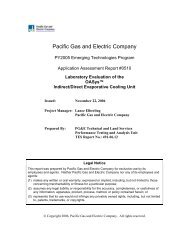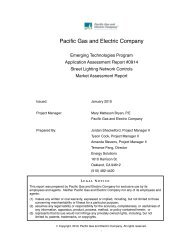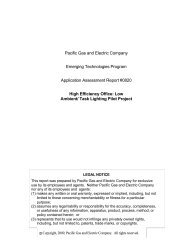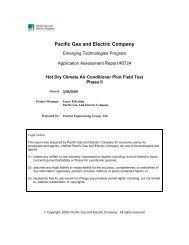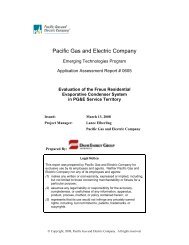Parking Lot LED Lighting Assessment Final Report - Emerging ...
Parking Lot LED Lighting Assessment Final Report - Emerging ...
Parking Lot LED Lighting Assessment Final Report - Emerging ...
You also want an ePaper? Increase the reach of your titles
YUMPU automatically turns print PDFs into web optimized ePapers that Google loves.
PROJECT RESULTS AND DISCUSSION<br />
Electrical Demand and Energy Savings<br />
<strong>Parking</strong> <strong>Lot</strong> <strong>LED</strong> <strong>Lighting</strong> <strong>Assessment</strong><br />
The parking lot lighting consisted of seven 250 W metal halide (MH) fixtures. Based upon industry technical data,<br />
each MH fixture, consisting of the lamp and ballast, consumes 291 W. The new <strong>LED</strong> luminaire was stated as 135 W.<br />
This results in the <strong>LED</strong> luminaire using 52% less demand than the MH fixtures. Taking into account all seven<br />
fixtures in the parking lot, the annual reduction of energy usage is 18,396 kWh or 52% less as shown in Table 3.<br />
<strong>Parking</strong> <strong>Lot</strong><br />
(4165 Operating hours)<br />
Table 3: Demand and Energy Savings<br />
# of Units Power (W) Demand (kW) Reduction (%) Energy (kWh) Reduction (%)<br />
250 W MH 7 291 2.0 - 8,484 -<br />
135 W <strong>LED</strong> 7 139 1.0 52 4,053 52<br />
<strong>Lighting</strong> Performance<br />
For the assessment area, photopic illuminance and Correlated Color Temperature readings were taken. The focus<br />
of this section is on the parking area off the main entrance roadway. Photopic illuminance measurements were<br />
taken over a 175’ X 40’ area covering the one traffic lane and the parking stalls.<br />
Illuminance levels were measured on a 10’ X 10’ grid. The maximum and minimum illuminance levels were<br />
determined from all measurements. The ratio of these two values is known as the uniformity ratio. The<br />
Illuminating Engineering Society of North America recommends a minimum light level of one foot-candle and a<br />
maximum uniformity ratio for parking lot of 10:1. Table 4 contains the photopic illuminance data and uniformity<br />
ratios. It is evident that neither light source meets IESNA requirements in terms of maximum uniformity ratio or<br />
minimum light level. While the <strong>LED</strong> setup appears worse than the MH setup by IESNA numbers, in reality the <strong>LED</strong>lit<br />
parking lot “feels” a lot brighter than the MH setup, and appears perfectly fine in terms of light distribution and<br />
light quality. It was not in the scope of this study to determine from parking lot users or facility management<br />
whether they were satisfied with light levels and light quality.<br />
Luminaire<br />
Grid Points<br />
Illuminated<br />
(%)<br />
Table 4: Photopic Illuminance Results<br />
Average<br />
Illuminance<br />
(fc)<br />
Max<br />
Illuminance<br />
(fc)<br />
Min<br />
Illuminance<br />
(fc)<br />
Average-to-<br />
Minimum<br />
Uniformity<br />
Maximumto-<br />
Minimum<br />
Uniformity<br />
MH 100 1.08 5.04 0.05 22:1 101:1 3,860<br />
<strong>LED</strong> 100 5.52 21.15 0.13 31:1 163:1 6,280<br />
Economic Performance<br />
It is important to note that the cost and equipment assumptions made in this section apply only to Resource<br />
Conservation District. Resource Conservation District was assessing their selection of <strong>LED</strong> luminaires in lieu of<br />
high wattage high intensity discharge (HID) metal halide (MH) light sources. Therefore readers should consider<br />
their specific variables such as maintenance, energy, luminaire/lamp costs and type of light distribution before<br />
drawing any conclusions about the cost effectiveness of <strong>LED</strong> luminaires. For <strong>LED</strong> luminaires, luminaire/lamp<br />
lifetime is a function of all components of the luminaire (<strong>LED</strong>s, driver, housing, coatings, etc.), electrical and<br />
Page 11 of 15<br />
CCT



